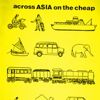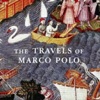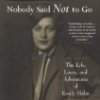Nine Subversive Travel Books
Travel Books: Thomas Kohnstamm celebrates books that really rocked the boat
01.12.10 | 12:17 PM ET

Take a spin through the travel section at your average Barnes & Noble and you’ll be confronted with memoirs about learning to cook Italian comfort food under the tutelage of a wisecracking Tuscan grandmother, a meditation or 12 on rediscovering romance in the shadow of the Eiffel Tower and stories about how weird China is—written by monolingual, white Americans.
ALSO SEE: Nine Subversive Travel Novels
The mainstream travel genre does indeed favor saccharine escapism. And there is nothing wrong with upbeat armchair travel. But non-fiction travel writing can also be so much more. Travel writing has long been a source of subversive thought and an incisive commentary about mankind and the world around us. Here are nine titles that have really rocked the boat.
‘The Motorcycle Diaries’ by Ernesto ‘Che’ Guevara
 Since exceedingly successful capitalists like Britney and Jay-Z donned Che T-shirts (not to mention millionaire Mike Tyson’s Che tattoo), it’s become trite to use Guevara as an example of anything seriously subversive. However, Guevara’s youthful Motorcycle Diaries is rebellious in ways that are not immediately obvious. This travelogue shows Ernesto the Medical Student developing a sense of Pan-Latin Americanism that fuses the interests of indigenous Andean peasants with traditional adversaries like upper-middle-class Argentine intellectuals (i.e. Guevara). The book ventures a unified regional opposition to U.S. hegemony and global capitalism’s sometimes ravaging effects on Latin America.
Since exceedingly successful capitalists like Britney and Jay-Z donned Che T-shirts (not to mention millionaire Mike Tyson’s Che tattoo), it’s become trite to use Guevara as an example of anything seriously subversive. However, Guevara’s youthful Motorcycle Diaries is rebellious in ways that are not immediately obvious. This travelogue shows Ernesto the Medical Student developing a sense of Pan-Latin Americanism that fuses the interests of indigenous Andean peasants with traditional adversaries like upper-middle-class Argentine intellectuals (i.e. Guevara). The book ventures a unified regional opposition to U.S. hegemony and global capitalism’s sometimes ravaging effects on Latin America.
‘The Art of Travel’ by Alain de Botton
 Like many of de Botton’s books, The Art of Travel dissects a popular theme (travel) and gives you iconoclastic philosophy 101. This series of essays argues, perhaps correctly, that most people don’t enjoy travel as much as they do anticipating it or reflecting upon it. He also explores our motivations for travel and how travel does or does not actually fulfill our expectations. This book is not outwardly subversive, but it inspires readers to consider who they are, how they relate to place and—once all romantic notions and delusions are stripped away—the actual purpose and effect of travel.
Like many of de Botton’s books, The Art of Travel dissects a popular theme (travel) and gives you iconoclastic philosophy 101. This series of essays argues, perhaps correctly, that most people don’t enjoy travel as much as they do anticipating it or reflecting upon it. He also explores our motivations for travel and how travel does or does not actually fulfill our expectations. This book is not outwardly subversive, but it inspires readers to consider who they are, how they relate to place and—once all romantic notions and delusions are stripped away—the actual purpose and effect of travel.
‘A Lady’s Life in the Rocky Mountains’ by Isabella Bird
 The British explorer Isabella Bird was an invalid whose doctor recommended fresh air. She took that literally, and spent most of the next 40 years on a solo world tour. A Lady’s Life in the Rocky Mountains, from 1879, is a volume of letters detailing Bird’s perilous and sometimes hilarious horseback exploration of the Wild West, as well as her chaste (or so she says) romance with a one-eyed outlaw, “Mountain Jim.” Maria Dahvana Headley says “Bird completely won my heart when she ascends Colorado’s Longs Peak in freezing temperatures, wearing a pair of men’s overshoes, and a ‘Hawaiian riding dress’ made of thin wool, and then actually apologizes for her lack of skill as a mountaineer.”
The British explorer Isabella Bird was an invalid whose doctor recommended fresh air. She took that literally, and spent most of the next 40 years on a solo world tour. A Lady’s Life in the Rocky Mountains, from 1879, is a volume of letters detailing Bird’s perilous and sometimes hilarious horseback exploration of the Wild West, as well as her chaste (or so she says) romance with a one-eyed outlaw, “Mountain Jim.” Maria Dahvana Headley says “Bird completely won my heart when she ascends Colorado’s Longs Peak in freezing temperatures, wearing a pair of men’s overshoes, and a ‘Hawaiian riding dress’ made of thin wool, and then actually apologizes for her lack of skill as a mountaineer.”
‘The Tourist: A New Theory of the Leisure Class’ by Dean MacCannell
 If de Botton’s “The Art of Travel” is the intro course to contrarian travel philosophy, then UC Davis professor Dean MacCannell’s The Tourist is the master class. It is true that his evaluation of the semiotics of tourism will never appeal to the average reader in quite the same way as “Under the Tuscan Sun,” but MacCannell uses tourism as a prism through which to explore an ethnography of modernity and modern values—and he manages to make the text accessible and entertaining regardless of the density of the subject matter. He explores such concepts as the commodification of culture, consumption of tourism markers, staged authenticity and the alienation of labor which forces us abroad in search of deeper meaning.
If de Botton’s “The Art of Travel” is the intro course to contrarian travel philosophy, then UC Davis professor Dean MacCannell’s The Tourist is the master class. It is true that his evaluation of the semiotics of tourism will never appeal to the average reader in quite the same way as “Under the Tuscan Sun,” but MacCannell uses tourism as a prism through which to explore an ethnography of modernity and modern values—and he manages to make the text accessible and entertaining regardless of the density of the subject matter. He explores such concepts as the commodification of culture, consumption of tourism markers, staged authenticity and the alienation of labor which forces us abroad in search of deeper meaning.
‘Across Asia on the Cheap’ by Tony Wheeler and Maureen Wheeler
 Asia’s overland Hippie Trail was already a well-worn counterculture experience by the time recent business school grad Tony Wheeler and his wife Maureen published Across Asia on the Cheap in 1973. However, the guidebook broke ground by mainstreaming the globalized backpacker counterculture at the polarized height of the Cold War. Moreover, it brought a DIY aesthetic and strong opinions to the travel guidebook genre. The lasting effect was that the book (and its subsequent series) constituted an easy entrée to alternative, independent travel that could be devoured by the masses.
Asia’s overland Hippie Trail was already a well-worn counterculture experience by the time recent business school grad Tony Wheeler and his wife Maureen published Across Asia on the Cheap in 1973. However, the guidebook broke ground by mainstreaming the globalized backpacker counterculture at the polarized height of the Cold War. Moreover, it brought a DIY aesthetic and strong opinions to the travel guidebook genre. The lasting effect was that the book (and its subsequent series) constituted an easy entrée to alternative, independent travel that could be devoured by the masses.
‘The Voyage of the Beagle’ by Charles Darwin
 It’s hard to top the cultural impact and backlash created by Darwin’s “On the Origin of Species” and its fundamental challenge to religious belief systems. True, “On the Origin of Species” is a science book, but it would not have been possible without Darwin’s earlier five-year voyage around the Southern Hemisphere on the HMS Beagle, which led to his travel memoir, The Voyage of the Beagle. The book pondered mysteries of the species that Darwin encountered in distant lands and raised many questions that he only fulfilled in “On the Origin of Species.” Later editions of “The Voyage of the Beagle” were re-worded to incorporate evolutionary insight into his original travels.
It’s hard to top the cultural impact and backlash created by Darwin’s “On the Origin of Species” and its fundamental challenge to religious belief systems. True, “On the Origin of Species” is a science book, but it would not have been possible without Darwin’s earlier five-year voyage around the Southern Hemisphere on the HMS Beagle, which led to his travel memoir, The Voyage of the Beagle. The book pondered mysteries of the species that Darwin encountered in distant lands and raised many questions that he only fulfilled in “On the Origin of Species.” Later editions of “The Voyage of the Beagle” were re-worded to incorporate evolutionary insight into his original travels.
‘The Worst Journey in the World’ by Apsley Cherry-Garrard
 A survivor of Robert Falcon Scott’s tragic 1910-1913 Antarctic exploration, Cherry-Garrard went on to write one of the great adventure travel books. But a quick glance at the title should give the reader a sense that this is not your typical celebration of derring-do. Cherry-Garrard takes the romanticism out of the grand notion of British exploration but simultaneously unleashes a scathing critique of life back home. Travel writer and editor Hunter Slaton notes how the book values lonesome, wretched Antarctic adventure—frostbitten fingers and all—over a predictable, comfortable life back in England when Cherry-Garrard writes: “For we are a nation of shopkeepers, and no shopkeeper will look at research which does not promise him a financial return within a year. And so you will sledge nearly alone, but those with whom you sledge will not be shopkeepers: that is worth a good deal.”
A survivor of Robert Falcon Scott’s tragic 1910-1913 Antarctic exploration, Cherry-Garrard went on to write one of the great adventure travel books. But a quick glance at the title should give the reader a sense that this is not your typical celebration of derring-do. Cherry-Garrard takes the romanticism out of the grand notion of British exploration but simultaneously unleashes a scathing critique of life back home. Travel writer and editor Hunter Slaton notes how the book values lonesome, wretched Antarctic adventure—frostbitten fingers and all—over a predictable, comfortable life back in England when Cherry-Garrard writes: “For we are a nation of shopkeepers, and no shopkeeper will look at research which does not promise him a financial return within a year. And so you will sledge nearly alone, but those with whom you sledge will not be shopkeepers: that is worth a good deal.”
‘The Travels of Marco Polo’ by Marco Polo and Rustichello da Pisa
 OK, so maybe Marco Polo didn’t actually become the right-hand-man of Kublai Khan. Maybe he never met Kublai Khan at all. And, yes, the most famous Venetian of all time didn’t write the book—that was left to a ghostwriter and cellmate, Rustichello da Pisa, who probably interjected additional fictional elements (after all, da Pisa was a romance writer who had already knocked out a King Arthur book). Fact checking was piss poor in the 13th Century, so we’ll never really know the truth. All of that aside, few books inspired so many Europeans to seek fortune and adventure outside of Europe and, thereby, alter the world. One person known to have been heavily influenced by The Travels of Marco Polo was a Genoese guy named Columbus.
OK, so maybe Marco Polo didn’t actually become the right-hand-man of Kublai Khan. Maybe he never met Kublai Khan at all. And, yes, the most famous Venetian of all time didn’t write the book—that was left to a ghostwriter and cellmate, Rustichello da Pisa, who probably interjected additional fictional elements (after all, da Pisa was a romance writer who had already knocked out a King Arthur book). Fact checking was piss poor in the 13th Century, so we’ll never really know the truth. All of that aside, few books inspired so many Europeans to seek fortune and adventure outside of Europe and, thereby, alter the world. One person known to have been heavily influenced by The Travels of Marco Polo was a Genoese guy named Columbus.
‘Nobody Said Not to Go—The Life, Loves, and Adventures of Emily Hahn’ by Ken Cuthbertson
 Unaccompanied female travelers were still a rarity in America by the 1920s—and so Emily Hahn dressed as a boy on a cross-country car trip. By 1948, Hahn had moved to the Belgian Congo, crossed Central Africa on foot, entered into a turbulent affair with a Chinese poet in Shanghai, and had two children with Britain’s chief spy in Hong Kong. Top that in 2010, Bear Grylls. This biography is an engaging introduction to a complicated and strikingly progressive woman. Follow it up with some of Hahn’s own work: 52 books and more than 180 New Yorker articles.
Unaccompanied female travelers were still a rarity in America by the 1920s—and so Emily Hahn dressed as a boy on a cross-country car trip. By 1948, Hahn had moved to the Belgian Congo, crossed Central Africa on foot, entered into a turbulent affair with a Chinese poet in Shanghai, and had two children with Britain’s chief spy in Hong Kong. Top that in 2010, Bear Grylls. This biography is an engaging introduction to a complicated and strikingly progressive woman. Follow it up with some of Hahn’s own work: 52 books and more than 180 New Yorker articles.![]()